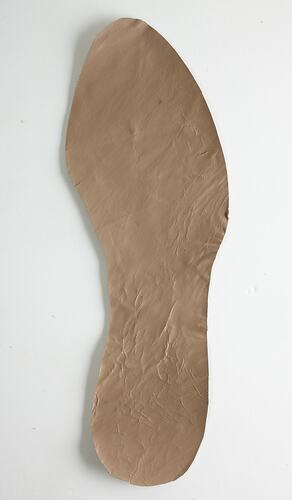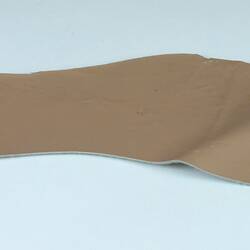Summary
This light tan/skin coloured left foot leather inner sole was used in the construction of Stanio Fancoff's shoes and/or boots sometime between the 1930s and 1970s. Created in supple material, this inner sole was the bed in which the client's foot sat. Although generic in shape, each inner sole was a particular sizing made to fit a particular styled shoe and thus, the inner sole was an integral part of the shoemaker's craft.
Stanio Ivanoff Fancoff was born in 1908 in Bojentsi, a small village in Bulgaria. At age 11, Stanio left home to learn the shoemaking trade. In 1929, he immigrated to Melbourne, settled in Fitzroy and began to work for the V.G. Zemancheff & Sons basket shoe factory in South Melbourne. In1936, he married Dorotea Georgi Touzou who had recently arrived in Australia. Around this time, Stanio set up his own shoemaking business from home, with Georgi, her cousin and sister weaving the shoes which he then assembled. Select shoe samples were then taken to Sydney and Tasmania for sale. In 1942, Georgi and Stanio moved to Broken Hill for Georgi's health; there daughter Nancy was born and Stanio set up a shoe shop/factory. In 1945, Georgi died and by 1950 Stanio and Nancy had moved to Adelaide where he again opened a shoemaking business and shop. He passed away in 1978, having been in the shoemaking business for 59 years. This collection documents his migration and working life experiences.
Physical Description
Left foot, hand-cut, light tan/skin coloured supple leather inner-sole. In good condition but exhibits extensive signs of creasing or crazing within the heel area and along the right hand edges. On the left edge at the upper quarter mark, a small crease appears. In addition, there are several impurity marks and close to the left top quarter edge a small area appears as if leather has been gouged and a part removed. While the front side exhibits a smooth appearance, the reverse side shows the skin's natural textured fibres.
Significance
This collection is significant in documenting a small migrant business as well as the fashion of a particular period. It is well provenanced and charts the application of trade skills in a new country. It also illustrates the stages of hand shoe manufacture from the 1930s, demonstrating the enduring nature of the tools and patterns that were used.
More Information
-
Collecting Areas
-
Acquisition Information
Donation from Nancy Vasileff, 21 Mar 2007
-
Maker
-
Classification
-
Category
-
Discipline
-
Type of item
-
Overall Dimensions
85 mm (Width), 249 mm (Height)
-
References
R.A. Salaman, 'Dictionary of Leather-working Tools c.1700-1950 and Tools of Allied Trades,' London: George Allen and Unwin (Publishers) Ltd, 1986 [Section 2: Boot and Shoe Maker pp18-185]. John Peacock. 'Shoes, The Complete Sourcebook,' London:Thames & Hudson Ltd, 2005. NAA holds file (online) on Vasil George Zemancheff, Fancoff's employer
-
Keywords
Boot & Shoemaking, Bulgarian Communities, Bulgarian Immigration, Immigration, Small Businesses, Tools


